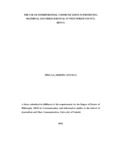| dc.description.abstract | This study investigated the use of interpersonal communication in promoting maternal
and child survival in West Pokot County, Kenya. Maternal and child mortality rate in
West Pokot County has been above the country’s average. The study sought to
investigate the different forms of interpersonal communication that have been used by
the health promoters to convey messages aimed at reducing maternal and child
mortality levels. It also identified the factors that affect the choice of each form of
interpersonal communication used in promoting maternal and child survival. The study
further examined the perceptions of the community on the various forms of
interpersonal communication used. A descriptive cross-sectional survey research
design and adopted a mixed research methods approach were adopted. A sample of
three hundred and ninety respondents was selected from the County through multistage
sampling technique that include; cluster, simple random sampling and purposive
sampling and additional qualitative data were collected using four key informant
interviews and four focus group discussions. The qualitative data were analysed
thematically while quantitative data were analysed using descriptive and inferential
statistics using SPSS programme, then presented using a combination of narrative
explanations, tables and graphs. The results from the study showed that face to face
interpersonal communication was the most popularly used form of interpersonal
communication at 75.4%, while the use of mobile telephone was only 14.1%.
Moreover, from the study, government policies, health indicators, national campaigns
and routine of the health workers were identified as the major factors that influenced
the choice of the interpersonal forms used. The attitudes and perceptions of the
community towards health workers were fairly rated at 53.8%. This study concludes
that though technology has permeated every sphere of life, still face-to face
interpersonal communication is supreme in a situation where action is required of
reception of the message. The study recommends that the government should
formulate a policy that incorporates the cultural aspects that encourage the upholding
of proper upkeep of children and pregnant mothers should be identified and used
during maternal and child survival campaigns. In addition the views of all the
stakeholders should be sought and incorporated into programmes aimed at enhancing
maternal and child survival campaigns. Again, messages should be designed and
directed at health workers to improve their attitudes towards their clients. | en_US |



